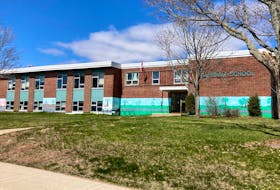ST. JOHN'S, N.L. — Within a few hours Saturday morning, 170 years of history was turned to rubble.
The stone building that most recently housed the John Howard Society sat at the west corner of Buchanan Street and Water Street since the mid-1800s.
Steele Hotels purchased the building at 426 Water St. and had it demolished to make way for the JAG Hotel expansion which will include a pedway across Buchanan Street and a concert hall.
Steele Hotels also purchased two other properties in the block for the expansion — the Gaze Seed building at 9 Buchanan St. and the office space at 430-444 Water St. which houses several businesses, including Kraken Robotics. Those structures are next to be demolished.
On Saturday beginning at around 8 a.m., the former John Howard Society building and a small attachment to the Gaze Seed building were the first structures of the block to be torn down.
Blair Temple is an archeologist with Gerald Penney Associates (GPA). He said the building was in largely original condition at the time of the demolition.
He went through the building in the days leading up to its demise so that he could take a photo record.
“They had the siding taken off and there were a number of things probably related to old chimneys or something — I just wanted to get a better idea of what was going on with those, and just architectural features. Because it’s gone. It’s our last chance.”
Through the course of its roughly 170 years, the building has housed everything from a 19th century fishing and supply company to several dry goods stores and even a Radio Shack in the late 1970s. In recent years, it’s become synonymous with the John Howard Society which was housed there.
By Saturday afternoon it was gone.

Heritage NL seeks stories about structure
Passersby could be seen photographing the rubble, and cars slowed down as drivers and passengers pointed towards the emptiness that was once a building.
One man lingered nearby for some time.
He wouldn’t give his name, but he smiled as he recalled his teenage years living on LeMarchant Road in the late 1970s. He said he often frequented the building with his friends when it housed a Radio Shack.
Heritage NL is hoping people will have all sorts of memories of the building. In a Twitter post over the weekend, they asked people to get in touch with any stories and memories they might have about the building.
Potential for old artifacts underneath
As for Temple, he expects the aftermath of the demolition might offer some clues about the history of that part of Water Street.
Temple was also the archeologist on site during the 2012 construction of JAG Hotel which exposed nearly an entire block of structural remains. One section at the corner of George Street West and Buchanan Street may predate the 1846 fire.
While the area around 426 Water St. has seen several archeological studies over the years, the section directly underneath 426 Water St. has never been investigated.
“There’s potential for some older material here,” said Temple, as he watched a crane haul down a portion of the structure.
“There’s potential for deposits older than the structure itself.”
Building housed dry goods, fishing supplies stores
Documents provided to The Telegram by GPA explain some of the history of the land at 426 Water St.

The earliest detailed map of St. John’s harbour is dated 1675 and it shows a double wharf on the harbour side of the area and two houses nearby. A 1751 map shows six stages near the shore, and the area around the demolished John Howard Building covered by flakes.
Beginning around 1800, the large merchant firm Miller and Fergus was established and the area became quite developed until it was all destroyed during the Great Fire of 1846, according to the GPA documents.
The documents go on to explain that the building that was demolished on Saturday — what we know as the former John Howard Society building — was erected at some time between 1847 and 1852 on property owned by the estate of John B. Thompson. While the west half of the building was occupied by the firm of Patrick Morris, the east half was probably offices for one of the largest fishing and supply companies in St. John’s at the time, owned by brothers Peter and Lewis Tessier.
“They had the siding taken off and there were a number of things probably related to old chimneys or something — I just wanted to get a better idea of what was going on with those, and just architectural features. Because it’s gone. It’s our last chance.” — Blair Temple
In the late 19th century many other businesses occupied 426 Water St., including Thomas Dwyer (1870), Farrell and Co. (1880), and Thomas Fitzgibbon’s dry goods firm (1885-97). Lebanese businessman Kalleem Noah took ownership in 1898 and it became a succession of dry goods firms owned by traders of Lebanese descent, including Boulas Brothers (1904) and then Anthony Michael (1913).
Now that the building is torn down, the footings of it will be removed and that’s when Temple will get a chance to see what artifacts might lie underneath.
Temple said it’s expected that full construction excavations for the JAG expansion development will go ahead this summer after the Gaze Seed building and the 430-434 Water St. offices are also demolished.
Temple said he hopes to be present for that work as well, and record any artifacts that become exposed with the demolitions and construction excavations.
Twitter: @juanitamercer_








